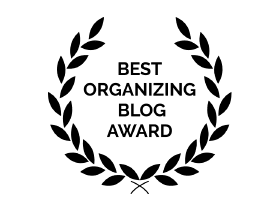Once upon a time, there was a sad woman. The woman was sad because her mother had died, and she wasn’t used to people dying. The sad woman did not know what to do with her grief, so she did nothing. Quite literally. No work, very little housekeeping, no cooking. The most she could manage was to ensure her children were safe and well – beyond that care she had no energy for much else. Her house became cluttered, and she was unaware.
But the months passed, and one morning she went to her medicine cabinet to get something for a headache (she had lots of headaches). When she opened the cabinet, it was so packed that all kinds of objects fell out in disarray and onto the already-covered countertop – bottles of vitamins, expired pain-relievers, half-empty band-aid boxes, dosing cups. One bottle broke open, scattering tiny, golden beads of Vitamin D across the bathroom floor.
At that moment, staring at the literal fallout from her time of grief, something inside her cracked open. She looked around in mild horror at the mess and noted how it expanded beyond that medicine cabinet to the counter, the floor, and the closet. Why were there clean socks in the bathtub? Why hadn’t she changed out that broken light bulb? With a lightning bolt of awareness, she understood how much she had neglected, and how she needed to start making some changes.
Our heroine paused to give herself a little grace (it’s not every year your mother passes, after all) and started picking things up. Once she got started, she continued, and it was a little easier. And she noticed how much relief she felt, taking a few small actions…
__________________
This story is actually mine (with a few embellishments to protect the innocent) from about sixteen years ago. I can tell it now without feeling too attached because, well…you guys know the rest of the tale. It was one of several defining moments that led me to what I do now. I’m not sharing it as a sob story, but rather as an example of a different way to make sense of a life order conundrum. Obviously getting my organizing game back on took more than just an afternoon of picking up vitamins, but the story illustrates the turning point.
When you have a small success, or make some progress, or even have a concern or challenge, it’s worth noting in an external way. How often have clients told me in a session that speaking their frustrations aloud makes all the difference? Sometimes when I ask where they want to end up, they share that we’ve already gotten part of the way there – purely because those challenges are no longer rattling around in their heads like uncounted spare change.
Creating something with all of that head clutter is even more powerful. According to research by the renowned developmental psychologist Jerome Bruner, facts are 20 times more likely to be remembered if they are part of a story. When we remember, we learn and deepen our awareness of what’s possible.
“Stories are genuinely symbiotic organisms that we live with, that allow human beings to advance.” – Neil Gaiman
Even if all I did was give my story a title it would be enough to cement it, and give me a touchpoint of understanding how insidiously clutter can take hold. I could call it something like “Pills and Bottles and Grief (Oh My).” If it weren’t already a story, the title would instantly bring me back to the memory and what I learned from the experience: grief can freeze up your decision-making, and you can figure out how to thaw it out.
You don’t have to be a great writer to write a story or creatively put something out into the world. I chose story because I like to write…but it could be anything.
I had the great privilege of being in a workshop with a past poet laureate of North Carolina recently (hey, by the way, did you know that it’s National Poetry Month?). She talked about the concept of “abiding images” – those picture memories frozen in our minds that can be powerful instigators for creativity. The abiding image you have could be the look of your cleared email inbox, your workspace after following through on a big work project, or a stack of papers and books after planning out your dissertation – nothing is too mundane.
I mean, come on – what could be more ordinary than a messy medicine cabinet? If I told my story as a haiku, it might go something like this:
She opened the door
And pills fell like tears, spilling
Time was ripe to clear.
Poetry can bring metaphor and humor into the mix, too…I could go on and on (so perhaps that’s the next post).
I’ve had clients share that they’ve created visual art, or made up a song or jingle that helps them remember how they’ve worked through some of their challenges or limiting beliefs. And no, they’re not professional artists or songwriters or touring musicians. Again, you don’t have to be, and it doesn’t have to be for anyone but you. You’re the person learning and shifting and putting a little mental distance between you and the chaos.
Have you ever put a success or accomplishment into creative expression? If not, what sort of life order story could you tell, and how would you tell it?




At one difficult period in my life, I kept a diary but wrote it as if it were a story about someone else. All the names, including my own, were made up. I’m not sure how helpful it was in terms of processing my feelings, but it did make it more fun.
Nothing wrong with making something difficult more fun, right? And I think it’s interesting to follow that impulse to write as if it’s someone else. Maybe it helps us to have some compassion for our own situations. Thanks for the comment, Janet.
I have found that making vision boards helps me understand what is important in my life and where I want to expand that life.
Oh, of course – I didn’t even think of vision boards, but you’re absolutely right. Telling a positive future story is powerful too! Thanks for stopping by and commenting.
Wow, I love this post. And I love your Haiku. And I’m sorry about the loss of your Mom. I know personally that I remember things much better when they are part of a song or story, so this makes sense to me. Visualizing where you want to be, perhaps in contrast to where they’ve been or where they are, could be so powerful. In addition to talking about how we want things to look in our life, it is also good to consider how we want to feel, right? I’m no poet, but here is my idea…
Opened the medicine cabinet
And order appeared, welcoming her,
A peaceful, positive day ahead.
Wow, thanks so much for the comments and the poem, Seana. I love the idea of looking forward in a positive way!
The vulnerability and empathy that you combined to create this post reflects what a warm, amazing person — and professional organizer — you are. I find that clients often tell the same *old* story so often that they don’t give themselves a chance to create and live a new one; sometimes I treat it like a television show and ask them, what would happen if there were a new season? A reboot? Your story and poem give life to what has happened and brings a new story into being, which is the most important part. Amazing!
Ooh, I’m liking the television show angle – lots of ways you could take that one. Is the situation reality TV? A soap opera? An old 70s sitcom with a studio audience? Thank you for the kind words and for commenting, Julie!
I love this post. I have transformed my grief into a creative expression as well. I recently updated and designed a heritage scrapbook with all our family’s relatives in it. I gathered photos I loved and shared stories on the scrapbook pages. It was a little sad being my mother-in-law passed a year ago. I was also able to revisit other images of my long past parents and grandparents. I created a shadow box of “the women in my life” that showed me their strength and how they succeeded in life. It is displayed on the shelf near my office, and I look at it every morning for inspiration to move forward.
That sounds like an amazing project, Sabrina. I have something similar that I created after my father passed – a collage of very old photos of his entire family (which was huge). A very resilient, persistent group of people that lived through a lot in the 20th century. I have it up in my office to remind me of their strengths. I’m happy the post resonated for you, and I very much appreciate the comment.
Thanks for sharing your story.
I have seen many clients with traumatic events in their lives suffer from decision overload. So many things (and decisions) happening at once they just stop. They need time to heal.
When they turn the corner and healing begins it is therapeutic to move forward and it’s an honor to help them do it.
The impact of that decision overload is so often overlooked. People think they “should” be able to take action, but you’re so right that the healing has to happen first. Thanks for stopping by, Janet.